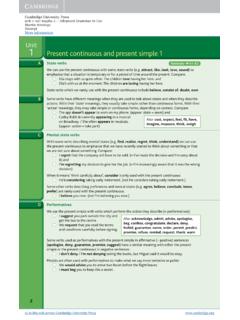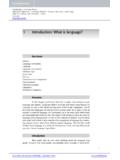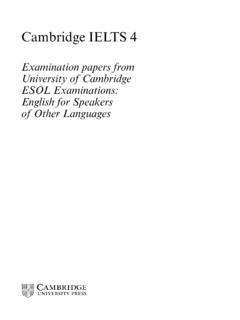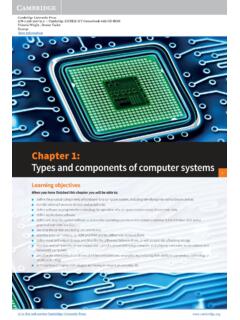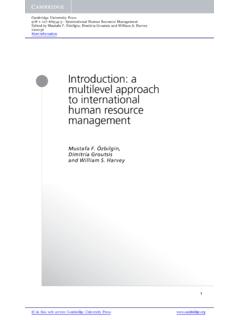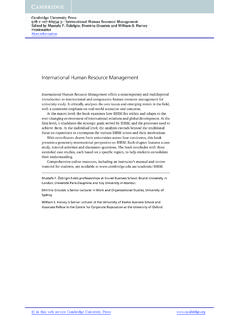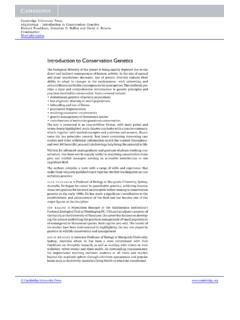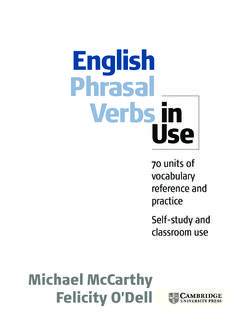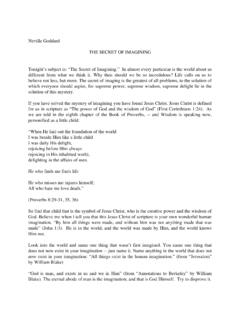Transcription of Introduction: Imagining audiences
1 1 introduction : Imagining audiencesKatharine A. Craik and Tanya PollardImagInIng lIterature s effectsHow did early modern writers imagine the effects of plays and poems on minds, bodies, and souls? In what ways does the history of theatrical or literary experience overlap with the history of humors, passions, and emotions? Throughout early modern texts, writers depict playgoers and readers responding to imaginative literature both affectively and physio-logically. In tragedies, audiences at plays-within-the-play are devastated, brought to tears, startled, and killed; in comedies, they are moved to laughter, driven to lust, and agitated into redirecting the plot. Letters and poems within plays of all genres, meanwhile, lead readers to react with anger, grief, or pleasure. Poems, similarly, meditate on the transformative effects of reading, watching, and hearing.
2 Satires and epigrams describe pricking readers into states of aggrieved indignation, or galling, lancing, or purging their targets. Love poems envision pressing readers into states of longing or embarrassment, epithalamia are described as festive restora-tives, and elegies aim to nourish and console the bereaved. Poems and plays alike were imagined to affect those who encountered them in ways that could be threatening, inflammatory, dangerous, or soothing, com-forting and the prominence of scenes of reading and watching imagina-tive literature in early modern texts, and authors insistent attention to the consequences of such encounters, critics have had surprisingly little to say about the period s investment in Imagining literature s impact on feeling. The absence of this discussion is striking given how urgently the topic impinges on current critical conversations.
3 For some time now, his-tories of the body and sexuality have been at the fore of early modern studies. Influential scholarship by Gail Kern Paster, Jonathan Sawday, David Hillman and Carla Mazzio, Jonathan Gil Harris, and Michael Schoenfeldt established the pervasiveness of the period s anatomical and in this web service Cambridge University PressCambridge University Press978-1-107-02800-5 - Shakespearean Sensations: Experiencing Literature in Early Modern EnglandEdited by Katharine A. Craik and Tanya PollardExcerptMore informationKatharIne a. craIK and tanya Pollard2humoral assumptions, and their significance for our understanding of lit-erary representations of bodies and More recently critical attention has turned to early modern conceptions of emotion and its relationship to the body.
4 Important books by Paster, Mary Floyd-Wilson, Katherine Rowe, Bruce Smith, and Matthew Steggle have delineated the distinct-ive contours of emotional experience in a pre-Cartesian moment in which bodies and minds were understood to be intimately Floyd-Wilson and Garrett Sullivan, like Paster, have called attention to the permeability not only between minds and bodies, but between selves and their surrounding environments at a moment when the bound-ary between external and internal was Relatedly, a number of critics have directed our attention to the period s conceptions of the senses and their functions: the contributors in Elizabeth Harvey s Sensible Flesh have examined early modern theories of touch, and those in Lowell Gallagher and Shankar Raman s Knowing Shakespeare have explored the role of the senses in shaping this surge of attention within the early modern period, the interface between bodies and emotions has come to occupy a crucial position in a wide range of conversations.
5 In particular, the ambigu-ous and powerful concept of affect has attracted attention from scholars across a wide range of disciplines, including social and biological sci-ences as well as Theresa Brennan has distinguished affect from emotion by defining it as the physiological shift accompanying a 1 See Gail Kern Paster, The Body Embarrassed: Drama and the Disciplines of Shame in Early Modern England (Ithaca: Cornell University Press, 1993); Jonathan Sawday, The Body Emblazoned (London and New York: Routledge, 1995); David Hillman and Carla Mazzio, eds., The Body in Parts (London: Routledge, 1997); Jonathan Gil Harris, Foreign Bodies and the Body Politic: Discourses of Social Pathology in Early Modern England (Cambridge University Press, 1998); and Michael Schoenfeldt, Bodies and Selves in Early Modern England: Physiology and Inwardness in Spenser, Shakespeare, Herbert, and Milton (Cambridge University Press, 1999).
6 2 See Gail Kern Paster, Humoring the Body: Emotions and the Shakespearean Stage (University of Chicago Press, 2004); Paster, Katherine Rowe, and Mary Floyd-Wilson, eds., Reading the Early Modern Passions: Essays in the Cultural History of Emotion (Philadelphia: University of Pennsylvania Press, 2004); Bruce Smith, The Acoustic World of Early Modern England: Attending to the O-Factor (University of Chicago Press, 1999); and Matthew Steggle, Laughing and Weeping in Early Modern Theatres (Aldershot: Ashgate, 2007). 3 See Garrett Sullivan and Mary Floyd-Wilson, eds., Inhabiting the Body, Inhabiting the World (Basingstoke: Palgrave, 2007), and Paster, Humoring the Body. 4 Elizabeth Harvey, ed., Sensible Flesh: On Touch in Early Modern Culture (Philadelphia: University of Pennsylvania Press, 2003), and Lowell Gallagher and Shankar Raman, eds.
7 , Knowing Shakespeare: Senses, Embodiment and Cognition (Basingstoke: Palgrave, 2010). 5 See Brian Massumi, Parables for the Virtual: Movement, Affect, Sensation (Durham, NC: Duke University Press, 2002); Eve Sedgwick, Touching Feeling: Affect, Pedagogy, Performativity (Durham, NC: Duke University Press, 2003); Teresa Brennan, The Transmission of Affect (Ithaca: Cornell University Press, 2004); Patricia Clough, The Affective Turn: Theorizing the in this web service Cambridge University PressCambridge University Press978-1-107-02800-5 - Shakespearean Sensations: Experiencing Literature in Early Modern EnglandEdited by Katharine A. Craik and Tanya PollardExcerptMore informationImagining audiences3judgment, and claiming that all affects, including even flat affects, are material, physiological things.
8 6 In recent years cultural linguists have similarly explored the relationship between biology and emotional responses, raising provocative questions about ethnically specific and linguistically determined factors in emotional Scientists, meanwhile, are pursuing links between brain circuits and the expres-sion of emotion, seeking to measure emotional impulse and to explore the innate or acquired nature of emotional landscapes. Scientists now widely acknowledge that knowledge garnered by the emotions con-tributes in important ways to processes of reasoning, particularly the rapid form of judgment we call intuition. Their work has challenged the mind/body dualism long central to western medicine, so that emotion is increasingly understood as rooted in the body rather than as an elu-sive mental quality.
9 8 The attention to embodiment in current conversations about affect makes the early modern period, with its assumptions about the intrinsic-ally material and physiological nature of emotion, an especially rich site for exploring the nature of affect. Shakespearean Sensations is informed by recent interdisciplinary conversations about emotion, but adds historical, social, rhetorical, and especially literary perspectives to these conversa-tions. Late sixteenth- and early seventeenth-century writers not only iden-tified emotional experience firmly with the body, but also privileged the sensations aroused by imaginative literature. In the texts explored in this volume, men and women respond to plays and poems not only with their minds and souls but also with their hearts, hands, viscera, hair, and skin. Such responses suggest an important prehistory for current psychobio-logical investigations; they also uncover the ways that authors aspired to affect the inner equilibrium of readers and audience members, and the cultural consequences of such (Durham, NC: Duke University Press, 2007); and Melissa Gregg and Gregory Seigworth, eds.
10 , The Affect Theory Reader (Durham, NC: Duke University Press, 2010). 6 Brennan, Transmission of Affect, 5 and 6. Massumi writes: Call the coupling of a unit of quasi cor-poreality with a unit of passion an affect: an ability to affect and a susceptibility to be affected. An emotion or feeling is a recognized affect, an identified intensity as reinjected into stimulus-response paths .. Emotion is a contamination of empirical space by affect, which belongs to the body without an image (Parables for the Virtual, 61). 7 See, for example, Anna Wierzbicka, Emotions Across Language and Culture: Diversity and Universals (Cambridge University Press, 1999), esp. 11 and 28. 8 Antonio Damasio s Descartes Error: Emotion, Reason and the Human Brain (London: Vintage Books, 1994) investigates the neural underpinnings of reason (xxi); the quotation appears on xxiv.

